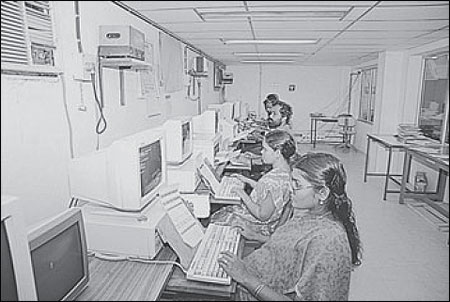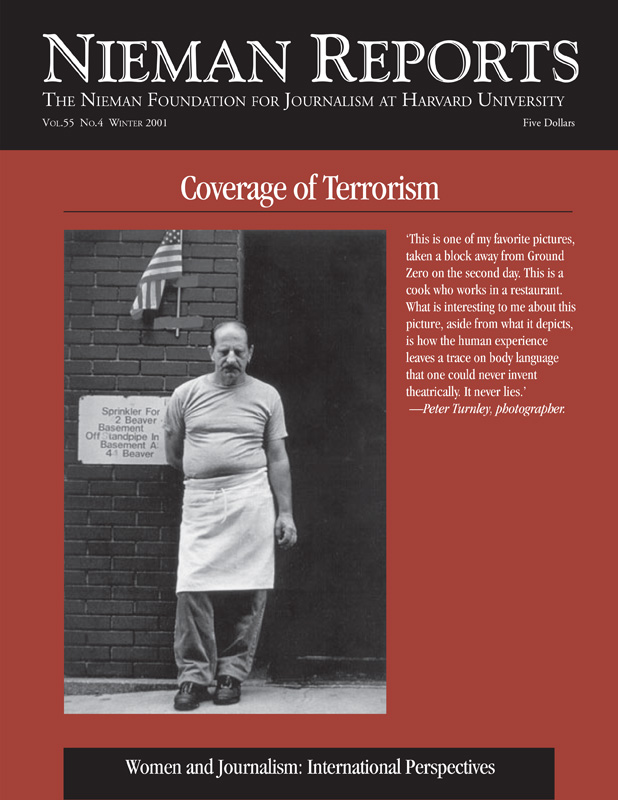
Indian journalists of both sexes are covering assorted aspects of the terrorist attacks in the United States, the retaliatory military attacks on Afghanistan, the implications of both for India, South Asia and the world, and the subsequent worldwide panic about the apparent spread of anthrax. Women have been conspicuous by their presence in the Indian media during this period as correspondents and commentators, editors and anchors, interviewers and hosts of current affairs programs, especially on some high-profile television news channels and in the indigenous English-language press.
However, it is difficult, if not dangerous, to deduce from this discernible reality that gender is no longer an issue in the Indian media. The story about six blind persons and their descriptions of an elephant—based on the part of the animal they were able to touch and feel—is appropriate to recall in this context. Sub-continental India is arguably the mother of all elephants, and the Indian media is one of her sizeable pachydermatous progeny. Both defy definitive description. Nevertheless, some clarity about the current situation of women in the Indian media, particularly the press, has emerged from discussions among women journalists within the country over the past couple of years.
There is little doubt that the number of Indian women in journalism had reached an unprecedented high by the turn of the millennium, although there is still no quantitative data to corroborate this observable fact. In the print media, female bylines have become commonplace during the past decade, not only in magazines and features sections but also on the news and editorial pages of dailies, including the front page. Apart from a large number of female staff reporters and sub-editors (or copyeditors), the Indian press currently boasts many women who are senior editors (including political and financial editors), chief reporters, chiefs of bureaus, special and foreign correspondents, business journalists, sports reporters and columnists, not to mention magazine editors and feature writers. It also harbors a few female sports reporters and photojournalists, as well as a couple of female cartoonists.
Women journalists now write on a wide range of current events and issues spanning a broad spectrum of subjects, including high-profile topics such as politics, business and economics, international relations and what is euphemistically known as defense. A number of women have managed to storm the citadel of hard news coverage. Many are recognized for their reportage from various areas of conflict in and around the country, having broken exclusive stories and secured rare interviews with leaders of militant organizations operating in these hot spots. Several women journalists have been associated with some of the most sensational scoops of recent years. Quite a few have also made names for themselves in the prestigious field of political reporting or analysis or both.
However, this apparently encouraging state of affairs is far from universal. There are significant differences in the situation of women journalists across the country and the press. For instance, the growing number of women in the metropolitan media workforce has created the impression that the barriers that once restricted women’s entry into the press have been overcome. But resistance to the recruitment of women still persists in many places and in certain sections of the press.
Similarly, the increasing visibility of women in the indigenous English-language print media—generally known as the mainstream, national press because of its unique reach and influence—suggests that there are no more impediments in women’s path to the top of the editorial pyramid. But many female journalists still experience slow and limited progress, if not total stagnation, in their careers. And the existence of a glass ceiling, which currently keeps women from occupying the very top spots in the editorial hierarchy (of newspapers, in particular) is widely acknowledged, even by women who have reached relatively high positions within their news organizations.
The spectacular success of a number of women in a wide range of high profile areas of journalism hitherto assumed to be male terrain implies that there is nothing to stop competent and determined women from fulfilling their professional dreams. However, the tendency to relegate women to particular functions and beats within the press has not completely disappeared. And many women allege that they are not given a chance to demonstrate their capabilities, especially in what is commonly, if erroneously, viewed as hard core, mainstream journalism.
Gender-based problems are particularly acute in the Indian language press, which thrives in at least 100 languages and dialects, and reaches a much larger proportion of the country’s reading public than the more conspicuous English press. Another factor that bears consideration in this context is the reality of minorities within minorities. If race piggybacks on gender, and vice versa, in some parts of the world, in India class, caste, creed and ethnicity often play a critical role in determining who, even among women, gains entry into the media and has the opportunity to rise in the profession, although, at present, no data exists about the socioeconomic and cultural composition of the Indian press corps.
There is little doubt that women have contributed significantly to broadening the scope of press coverage to include more and better reporting on and analysis of social issues in general and women’s issues in particular. Women journalists have definitely played an important role in highlighting a wide range of issues related to human development and rights, social and economic justice, culture and other vital aspects of life and society that were earlier neglected by a press traditionally preoccupied with politics (in the narrow sense) and government. Women have been noted for their coverage of social trends. They are also credited with having introduced more human interest in the media, even while covering hard news.
Back in the 1980’s, the reports of many women journalists reporting on caste, communal or ethnic conflicts stood out from the rest because they included the experiences and perspectives of ordinary people caught in the crossfire, especially women and children. Now more journalists of both sexes seem to focus on the human dimension of such stories.
At the same time, it is difficult to state categorically that the presence and rise of women in the Indian media have had a perceptible, positive impact on mainstream journalism and media coverage as a whole. Women’s capacity to influence the agenda, practice and output of the media is currently limited by several factors. They include:
- The number of women in key decision-making positions is still relatively small.
- Many successful women journalists tend to adopt, or at least adapt to, the prevailing values and norms of the profession, like the majority of their counterparts elsewhere, in the media as well as in other professions. At present, such conformity appears to be an effective strategy for career advancement; those who retain an alternative worldview seem to come up against the glass ceiling sooner rather than later.
- A third inhibiting factor is the apparent shift in the Indian media’s priorities and preoccupations during the past decade due to a number of developments, especially within the economy, that have affected many aspects of society, including the media. Influential sections of the media today seem obsessed with the lives of the bold and the beautiful, the rich and the famous, the pampered and the powerful, and consequently less receptive to the interests and concerns of those who do not belong to this charmed circle. In this altered media environment, there is less time and space for in-depth coverage of serious issues, including many relating to gender.
Like the media everywhere, the Indian press, too, has a predilection for events, especially dramatic ones that involve or threaten violence or conflict. As a result, the gender-related issues that routinely receive the most media attention are those that fit into dominant perceptions of what constitutes news. Among these are violent atrocities such as rape and dowry-related murder and political hot potatoes, like the recent threat by a militant organization in Kashmir to disfigure or kill girls and women who ignore its edict on the wearing of the burka (an alien garment for Kashmiri women, including Muslims). Even here, the notoriously brief attention span of the media—a familiar global problem—militates against sustained, consistent coverage. For instance, a spurt in prominent reporting about “dowry deaths”—often spurred by a particularly sensational case, a public demonstration, a court judgment, and/or release of new research findings—is usually followed by a fallow period when the same kind of news reverts to being treated as a routine event and is relegated to its usual obscure place within the paper.
The media’s tendency to focus on events rather than processes often results in the neglect of many important issues concerning women—for example, the combination of chronic malnutrition and overwork that threatens the health of millions of women and the initiation into public life of thousands of rural women elected to institutions of local governance from the mid-1990’s onwards. When such issues do get covered, it is because of the efforts of women—inside and outside the media—more often than not. However, there are signs of hope in what can appear a bleak scenario. Certain kinds of gender-related issues now seem to be accepted by both men and women in the media as legitimate subjects for mainstream media coverage. At least one journalism school offers an elective course on gender amid reports that others might soon do so.
Meanwhile, awareness and concern about gender-related issues are very much alive and kicking among a cross section of media women today, including young professionals. According to one young female journalist, this is not just because they are women but because such issues are inherently important and involve a section of the citizenry that does not easily find a voice in the media. “Our generation has little idealism left,” says another. “But the little that remains s
Ammu Joseph is a freelance journalist and author based in Bangalore, India. She has written two books, “Whose News? The Media and Women’s Issues,” co-authored/edited with Kalpana Sharma (Sage Publications, Delhi, 1994), and “Women in Journalism: Making News” (The Media Foundation/Konark Publishers, Delhi, 2000). She is on the visiting faculty of the Asian College of Journalism, Chennai, where she teaches a course on covering gender. She writes mainly on issues relating to women, children, human development, and the media.




